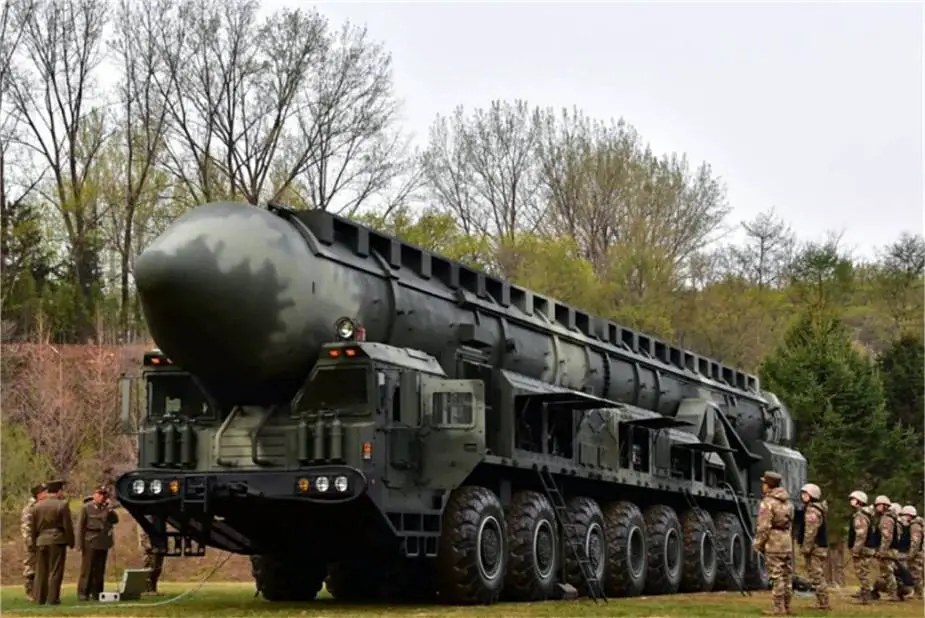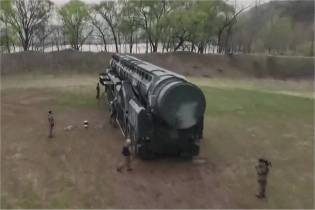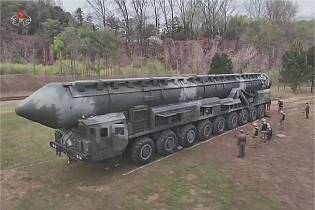- Army
- Air Defense Systems
- Anti-tank systems and vehicles
- Armored Vehicles
- Armoured personnel carriers
- Artillery Vehicles and Weapons
- Command Post
- Communication Vehicles and Systems
- Electronic Warfare
- Engineer | Maintenance Vehicles
- Infantry Fighting Vehicles
- Main Battle Tanks
- Missiles
- Tactical and Logistic Vehicles
- Radars
- Unmanned Systems
- Weapons
- Navy
- Air
Hwasong-18 ICBM
Hwasong-18 ICBM
Three stages solid-fueled intercontinental ballistic missile - North Korea

Description
The Hwasong-18 is a new generation of North Korean-made intercontinental ballistic missile (ICBM) that was first unveiled during a military parade in February 2023. This advanced missile represents a significant leap forward in the Democratic People's Republic of Korea (DPRK) Armed Forces' strategic deterrence capabilities, with the potential to greatly enhance the effectiveness of their nuclear retaliatory posture and influence their offensive military strategy.
South Korea's Joint Chiefs of Staff (JCS) reported that the Hwasong-18 was test-launched for the first time on April 12, 2023, at approximately 7:23 am from a location near Pyongyang, the North Korean capital. According to South Korean military sources, the ballistic missile test conducted by North Korea on April 13 might involve this new missile type. The Republic of Korea (ROK) JCS noted that the Hwasong-18 was fired at a lofted trajectory, reaching an approximate distance of 1,000 kilometers before splashing down in the waters east of the Korean Peninsula.
South Korea's Yonhap news agency provided additional details, suggesting that the missile's peak altitude during its flight was likely less than 3,000 kilometers. South Korea's defense ministry has also noted that North Korea continues to advance its weapons systems, suggesting that they still require more time and effort to fully master the technology and that further tests may be conducted in the future.
As more information becomes available, further analysis and technical specifications of the Hwasong-18 ICBM will be crucial to understanding its capabilities and potential impact on regional security dynamics. The development of this new ICBM signifies a considerable transformation in the strategic landscape, necessitating a reassessment of regional security strategies.
Hwasong-18 ICBM variants:
- No variants at this time
Technical Data
| Launcher Unit |
|
The Hwasong-18 ICBM is road-mobile and carried by a 9-axles wheeled transporter erector launcher (TEL) vehicle to support the weight and size of the missile, allowing it to traverse various types of terrain. The missile is encased in a protective canister, which is mounted in the front-middle section of the TEL. This canister also serves as the launch tube when the missile is ready to be fired. To be launched, the missile is erected in a vertical position at the rear of the TEL. The use of a road-mobile TEL increases the missile's survivability and flexibility, as it is more challenging for adversaries to locate, track, and target the missile before launch. The crew cabins are located at the front of the truck on both the right and left sides of the missile, creating a U-shape around it. It is probable that the cabin also features necessary controls for operating the vehicle, as well as communication equipment to maintain contact with command centers and other units during transportation and launch operations.
|
| Missile |
|
The Hwasong-18 missile is three stages solid-fueled intercontinental ballistic missile (ICBM). Solid-fueled missiles use a solid propellant composed of fuel and oxidizer that is tightly packed into the rocket's motor. This mixture is stable and can be stored for long periods without significant degradation. Solid-fueled ICBMs have shorter launch preparation times because the propellant is already inside the missile, making them more responsive to sudden launch orders. Solid-fueled ICBMs are typically more mobile, as they can be easily transported on vehicles without the need for additional fueling equipment.
A three-stage ICBM is a type of ICBM that has three stages, or sections, that are used to propel the missile to its target. The first stage is the boost stage, which is responsible for lifting the missile off the ground and accelerating it to a high velocity. The boost stage typically uses a liquid-fueled rocket engine, which provides a high amount of thrust for a short period of time. Once the missile has reached a certain altitude and speed, the first stage falls away and the midcourse stage takes over. The midcourse stage is responsible for guiding the missile towards its target, using a combination of internal guidance systems and external tracking systems. The final stage of the missile's flight is the terminal stage, which is responsible for ensuring that the missile reaches its target with precision. The terminal stage typically uses a small rocket engine, which can make fine adjustments to the missile's trajectory to ensure that it hits its target. The range and altitude of a solid-fueled intercontinental ballistic missile (ICBM) depend on its specific design, size, and payload. Generally, ICBMs are designed to have a range of at least 5,500 kilometers (3,400 miles) to be classified as "intercontinental." However, some modern solid-fueled ICBMs can achieve much greater ranges, even exceeding 12,000 kilometers (7,500 miles) in some cases. As for altitude, ICBMs typically follow a ballistic trajectory, which takes them through the Earth's atmosphere and into space before reentering the atmosphere to reach their target. The peak altitude, or apogee, of an ICBM's flight path can vary depending on the missile's range and trajectory. For long-range ICBMs, the apogee can reach up to 1,200 kilometers (750 miles) or higher. Hwasong-17 may be capable of carrying multiple nuclear or conventional warheads. |
| Guidance Systems |
| Currently, there is no information available about the specific guidance system used in the Hwasong-18 intercontinental ballistic missile (ICBM). Due to the secretive nature of North Korea's missile program, it is difficult to ascertain the exact details of the guidance system employed. However, ICBMs generally use a combination of guidance systems, including inertial guidance, satellite-based navigation, or both, to accurately deliver their payload to the target. Inertial guidance systems use accelerometers and gyroscopes to measure the missile's acceleration, velocity, and position. This information is then used to adjust the trajectory and ensure the missile reaches its intended target. It is possible that the Hwasong-18 uses an inertial guidance system, possibly supplemented with satellite-based navigation like the Global Positioning System (GPS) or a regional equivalent. |
| Combat Use |
| Solid-fueled ICBMs such as the Hwasong-18 can be prepared for launch more quickly than their liquid-fueled counterparts, as they do not require time-consuming fueling procedures. This rapid readiness allows for a more immediate response to a perceived threat, potentially deterring adversaries from launching a first strike. It is designed to deliver nuclear or conventional warheads over long distances, typically thousands of kilometers. They are primarily used as strategic weapons for deterrence purposes. It can be used to target military installations, such as command and control centers, missile silos, air bases, naval bases, and troop concentrations. |
Specifications
| Type | Launcher vehicle |
| Solid-fueled ICBM intercontinental ballistic missile | Nine axles mobile truck TEL Transporter - Erector - Launcher |
| Country users | Weight Missile |
| North Korea | 55-60 tons (estimated) |
| Designer Country | Speed missile |
| North Korea | Mach 27 (33,100 km/h; 20,600 mph; 9,190 m/s) |
| Guidance Systems | Range missile |
| Inertial guidance, satellite-based navigation | 15,000 km |
| Warheads | Dimensions missile |
| Nuclear weapon, possibly MIRV - 1.25 - 1.5 t | Length:? m; Width: ? m; Height: ? m |
Details View
 |
 |
 |
 |
Pictures - Video



























